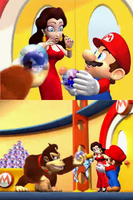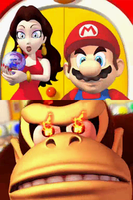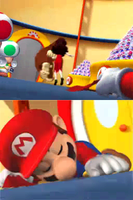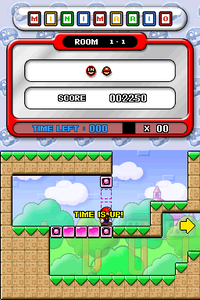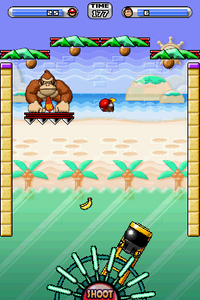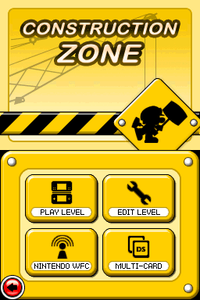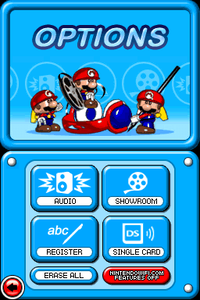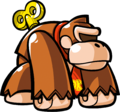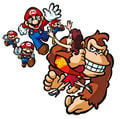Mario vs. Donkey Kong 2: March of the Minis
| Mario vs. Donkey Kong 2: March of the Minis | |||||||||||
|---|---|---|---|---|---|---|---|---|---|---|---|
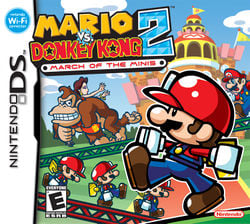 For alternate box art, see the game's gallery. | |||||||||||
| Developer | Nintendo Software Technology Corporation Nintendo SPD Group No.3 | ||||||||||
| Publisher | Nintendo | ||||||||||
| Platform(s) | Nintendo DS, Virtual Console (Wii U) | ||||||||||
| Release date | Nintendo DS: Template:ReleaseVirtual Console (Wii U): Template:Release | ||||||||||
| Language(s) | English (United States) French (France) German Spanish (Spain) Italian Japanese | ||||||||||
| Genre | Puzzle/Action | ||||||||||
| Rating(s) |
| ||||||||||
| Mode(s) | Single-player | ||||||||||
| Format | Wii U: Nintendo DS:
Game Card
| ||||||||||
| Input | Wii U: Nintendo DS:
| ||||||||||
| Serial code(s) | Template:Serials | ||||||||||
Mario vs. Donkey Kong 2: March of the Minis is an action puzzle game for the Nintendo DS and the sequel to Mario vs. Donkey Kong. Rather than being a platformer in the same way as its predecessor, this game instead places a focus on controlling the Mini toys created by the Mario Toy Company and guiding them through each level; this is the standard form of gameplay for later games in the Mario vs. Donkey Kong series. In addition to Mini Mario toys returning, three new toys are introduced in this game, including Mini Donkey Kong, Mini Toad, and Mini Peach. This game also marks the first appearance of Pauline in the Super Mario franchise since Donkey Kong for the Game Boy. The game's title is an allusion to the orchestral piece "March of the Meanies" from the film Yellow Submarine.
Shortly before the release of the game, the 2006 version of the Camp Hyrule website featured a Super Mini Mario World section, which provided users with information about the game. As an additional promotion, a browser game titled Mario vs. DK 2: Cannon Kaos was published on the Nintendo Arcade webpage. The game was rereleased for the Wii U's Virtual Console in Europe and Australia in September 2015 (the same day Mario vs. Donkey Kong was released on the same platform in those regions), in Japan in August 2016, and in North America in October 2016.
Story
The Mario Toy Company returns with a commercial promoting the new Super Mini Mario World, which is an outdoor amusement park centered around the Mini Marios, Mini Peachs, Mini Toads, and Mini Donkey Kongs. A crowd of Toads is shown watching Pauline and Mario, who is about to cut the ribbon to open the park. Donkey Kong, one of the Mario Toy Company's employees,[1] is also in the crowd. He immediately falls in love with Pauline and rushes to her, presenting her with a Mini Donkey Kong. However, Mario hands out a Mini Mario, which Pauline chooses instead of the Mini Donkey Kong. A heartbroken Donkey Kong becomes furious and breaks down a sales post of Mini Marios, even crushing one with his feet. He then heads toward the elevator, grabbing Pauline on his way and knocking Mario to the floor. As Donkey Kong enters the elevator with Pauline, Mario gets up and runs toward it, but its doors close before he can reach it, and Donkey Kong brings Pauline up to the roof of the building. Mario is unsure of what to do until two Mini Marios come to offer help.
In the ending, Mario reaches the top of the building and finds Pauline safe with many presents in a room on the roof. Donkey Kong looks apologetic for his actions as a Mini Mario races across the floor to meet a Mini Donkey Kong. Pauline picks up the Mini Donkey Kong and kisses it, making Donkey Kong happy. Toads appear and everyone waves, leading into the credits.
Gameplay
Main Game
Unlike in Mario vs. Donkey Kong, Mario is not a playable character in this game, as he has only a supporting role. Instead, Mini Mario toys appear as playable characters in each level. The objective of each level is to control the Mini Marios, as well as manipulate the environment around them, in order to direct each Mini Mario to the exit, a portal-like doorway with a red "M" on top. This focus on controlling Minis laid the foundation for future games in the Mario vs. Donkey Kong series. Each standard level contains a minimum of two Mini Marios and a maximum of eight. There are 240 Mini Marios in total.

The player can scroll around each level using the or the
![]()
![]()
![]()
![]() buttons. Aside from this, gameplay uses only the
buttons. Aside from this, gameplay uses only the stylus and Touch Screen:
- Tapping a Mini activates it.
- Tapping a moving Mini causes it to halt.
- Minis automatically change direction when hitting a wall or another Mini.
- If a moving Mini touches a stationary Mini, it will start moving.
- Swiping a Mini left or right moves it in that direction or switches its direction.
- Swiping in the same direction across multiple Minis changes the direction of all of them.
- Swiping up makes a Mini jump.
- If a Warp Pipe is directly below a Mini, swiping down on the Mini makes it enter the Warp Pipe. Minis can also enter a Warp Pipe directly above them by jumping into them.
- A Mini hesitates and makes a warning noise if it is about to fall into spikes or another danger that can break it, including large heights.
To guide the Minis to the exit, the player must manipulate elements of the level itself as well as the Minis, so they can reach the exit without being destroyed. Level elements that appear frequently throughout the game include Color Blocks, which can be placed if the player has a sufficient number of them stored, as shown in the inventory on the Top Screen. For example, in Room 1-1, a wall of Pink Blocks can be picked up and placed elsewhere to form a floor, allowing Minis to cross and reach the level's Mini Mario Card. Other examples of level elements include elevators, which can be moved up and down with two separate buttons, and conveyor belts, which can be reversed using a conveyor switch. At any point during the game, if the player enters the Nintendo DS's Sleep Mode by closing their system, Mario says one of four lines:
- "Hey! Come back here, you!"
- "Hey, come back here, you big-a monkey!"
- "Not again!"
- "I love this game!"
Mario says different lines if the player exits Sleep Mode by opening their system:
- "What's up?"
- "Okey-dokey!"
- "Here we go again!"
- "Let's play again!"
This feature was reimplemented in Mario vs. Donkey Kong: Minis March Again! and Mario vs. Donkey Kong: Mini-Land Mayhem!.
Time limit
Each level features a time limit, which does not start counting down until either Color Blocks are picked up or a Mini is activated. The player can scroll around the level before starting its timer, in order to plan their actions.
A level's timer starts at 300 seconds of a Time Bonus. If this Time Bonus exceeds 0 after the level has been completed, it will be multiplied by 10 and added to the player's score on the results screen. However, if this Time Bonus reaches 0 and the level is still being played, the time counter on the Top Screen turns blue, and its text changes from "Time Bonus" to "Time Left". The counter then resets to 300 seconds and continues to count down. If the Time Left counter reaches 0 and the level is still being played, the game displays a "Time Is Up!" message, Mario exclaims "Mama mia, time's up!" and the game is over, regardless of how many Minis entered the goal. Therefore, the player has 300 seconds to earn a Time Bonus, and 600 seconds in total to complete the level.
Scoring and stars
Scoring is specific and precise for each level. Small and big coins are spread throughout the levels (worth 50 and 500 points respectively when collected). Collecting the level's Mini Mario Card is worth 1000 points. If the timer on the Top Screen reads "Time Bonus" instead of "Time Left", each second remaining on the timer is worth an additional 10 points. There are many bonuses that come into effect on the results screen after a level is completed:
- Each Mini that enters the goal is worth 1000 points.
- If all Minis enter the goal, 5000 points are awarded instead of awarding points for each Mini individually.
- Getting Minis into the goal very close to each other is called a Chain Goal. Starting at 1000, the Chain Goal bonus is doubled for each additional Mini in the chain; for example, 2 Minis in a row is 1000 + 2000 = 3000 points, and 4 minis in a row is 1000 + 2000 + 4000 + 8000 = 15000 points. The bonus increases exponentially. A sparkling effect surrounds the goal to signify the Chain Goal bonus is still active, and it lasts for about three seconds after the last Mini in the chain enters the goal.
- If a perfect Chain Goal is formed (all Minis enter the goal consecutively while it is still sparkling), another bonus of 5000 points is awarded.
- If a Gold Mini Mario is at the back of a perfect Chain Goal, the last bonus is doubled again (for example, 3 Minis = 1000 + 2000 + 8000 = 11000 point bonus).
- Finally, a nonstop bonus is awarded if a Mini is never stopped by the player by tapping on it (stopping at an elevator, on an enemy, or in a Warp Pipe does not cancel the nonstop bonus). This bonus is 1000 points per Mini; however, if none of the Minis are stopped, a bonus of 7000 points is awarded instead.
By meeting all of the criteria above and earning every possible bonus, the player can earn a gold star for the level. Below it is the
silver star and the
bronze star. It is possible not to receive a star after a level is completed, especially if the player loses more than one Mini Mario. Stars are used to unlock extras after completing the main adventure.
The following is a table of the bonuses for the number of Mini Marios that appear in each level, and the minimum scores needed to obtain each type of star. A ![]() indicates that a Gold Mini Mario is one of the Minis present in the level.
indicates that a Gold Mini Mario is one of the Minis present in the level.
| # of Minis | All Non-Stop Bonus | |
|---|---|---|
| 1a | 6000 | |
| 2 | 7000 | |
| 3 | 8000 | |
| 3 |
8000 | |
| 4 | 9000 | |
| 4 |
9000 | |
| 5 | 10000 | |
| 6b |
11000 | |
| 8c |
13000 |
a - Only in levels made in the Construction Zone
b - Only in Room 3-3 and levels made in the Construction Zone
c - Only in Room 8-3
Mini Game
- Main article: Shy Guy Smash!
Each of the first nine levels in a floor contains a Mini Mario Card, a card with a letter on one side and a Mini Mario head on the other side. When collected, all of the cards on a single floor spell "MINIMARIO", and appear in that order (i.e. Room 7-3 contains an "N" card).
Finding every Mini Mario Card on a single floor unlocks a minigame (parsed as a Mini Game) for that floor. In the minigame, titled Shy Guy Smash!, the player uses the stylus to tap Shy Guys that appear from Warp Pipes. Tapping a Shy Guy breaks it, adding 1 point to the score. Starting in Tropical Island, Bob-ombs also appear from the Warp Pipes; however, tapping them causes them to explode, subtracting 5 points from the score. The player must earn at least 25 points within 30 seconds to reach the minigame's goal score. If the player exceeds the goal score, it is set to the player's new record.
Boss battles
Each floor concludes with a boss battle against Donkey Kong, with a time limit of 180 seconds. The player must shoot Mini Marios upward from a cannon to hit Donkey Kong either directly or indirectly. On odd-numbered floors, the cannon can be moved left and right by swiping its handle[1] with the stylus, and the cannon only shoots Minis directly upward. On even-numbered floors, the cannon can be rotated in an arc formation by swiping its handle, and can shoot Minis at various angles. To shoot a Mini Mario, the player must tap the Attack Button[1] labeled "SHOOT". Additionally, the player can hold
![]() or
or ![]() to activate the Boss Cannon Indicator,[1] a guideline that indicates where a Mini Mario will travel when fired.
to activate the Boss Cannon Indicator,[1] a guideline that indicates where a Mini Mario will travel when fired.
During the first seven boss battles, Mini Marios can hit Donkey Kong directly to damage him. However, in Boss Game 2, Boss Game 4, and Boss Game 6, Donkey Kong is protected by the spiked platform he is standing on, making it more difficult for a Mini Mario to directly hit Donkey Kong. In Boss Game 8, Donkey Kong punches a Mini Mario if it touches him, causing the Mini Mario to break. Boss battles on even-numbered floors feature objects suspended from platforms at the top of the screen. Mini Marios can land on these platforms with proper timing to cause the objects to fall on Donkey Kong and damage him.
The number of Mini Marios the player has depends on how many Mini Marios they directed to the goal in the floor's first nine levels. A Mini Mario breaks if it touches a projectile. If all of the player's Mini Marios break, the game is over. After Donkey Kong takes six hits in each battle, he is defeated and the level is completed.
The player can also earn a score and a star for each of the first eight boss battles, but the score is calculated differently than in standard levels. The minimum score to receive a gold star is 1,000 multiplied by the total number of Minis on the floor. Each second left on the timer is worth 10 points, and each of the player's remaining Mini Marios is worth 1,000 points. Therefore, to earn a gold star for a boss battle, the player must direct every Mini Mario to the goal in the floor's previous levels, then defeat Donkey Kong without breaking a single Mini Mario. Alternatively, if Donkey Kong is defeated with 100 seconds or more left on the timer, the player can finish the battle with one less Mini Mario and still earn a gold star. Generally, a silver star is earned for retaining 75% of the total number of Mini Marios on the floor, and a bronze star is earned for retaining 50% of the total.
Construction Zone
Mario vs. Donkey Kong 2: March of the Minis introduces a game mode known as Construction Zone, where the player can create and play their own custom levels, as well as share these levels with other players. The player can use the Multi-Card feature to exchange levels with another player who has a separate Nintendo DS system and game card. Prior to the discontinuation of the Nintendo Wi-Fi Connection service, players could use the Nintendo WFC feature of the Construction Zone to send and receive levels online.
Options
In addition to the Main Game and Construction Zone modes, the game's title screen also features an Options menu, where the player can adjust settings and view unlockables. There are six buttons present in the Options menu:
- Audio: The player can adjust the game's audio settings to Stereo, Surround, or Headphones. After completing the main adventure, the player can hear every sound effect and music track in the game. There are 144 sound effects and 77 music tracks in total.
- Showroom: The player can view previously seen movies and images, as well as view the credits and change a cosmetic feature.
- Movies: Players can watch the four real-time movies from the game. However, only one is unlocked at the beginning; the rest must be unlocked by playing through the Main Game mode.
- Pre Title: Unlocked from the beginning.
- Introduction: Unlocked by starting the Main Game mode.
- Ending: Unlocked by defeating Donkey Kong on the Roof.
- Musical: Unlocked by completing B2 in DK's Hideout.
- Gallery: Players can look at eighteen full-screen pictures from the game, which are unlocked as they are shown in the Main Game mode. Eight of the pictures are the intro screens shown before the first eight boss battles, while another eight pictures are the victory screens shown after completing each of the first eight boss battles. The penultimate picture is shown before the final battle on the Roof, and the final picture is unlocked from completing B1 in DK's Hideout.
- Credits: Replays the credits. The player must finish the Main Game at least once to unlock it.
- Title: On the title screen, Mini Marios walk across the bottom of the top screen. This cosmetic feature can be changed to feature other Minis, but stars are required to do so.
- Mini Marios: Unlocked from the beginning.
- Mini Toads: Requires all 80 bronze stars in the game.
- Mini Peaches: Requires all 80 silver stars in the game.
- Mini Donkey Kongs: Requires all 80 gold stars in the game.
- Movies: Players can watch the four real-time movies from the game. However, only one is unlocked at the beginning; the rest must be unlocked by playing through the Main Game mode.
- Register: Players can register their name as it appears in the Construction Zone and Wi-Fi Connection here.
- Single Card: A demo version of the game can be sent to another Nintendo DS without the game card.
- Erase All: This deletes all Main Game data and all Construction Zone levels, whether created or received, and it resets the player's friend code.
- NintendoWiFi.com Features: Players could choose to let their statistics be part of Nintendo's official Wi-Fi site.
Controls
– drag or tap objects; navigate menus
– scroll around level



 - scroll around level
- scroll around level
 - pause game; exit Shy Guy Smash!
- pause game; exit Shy Guy Smash!
 - activate Boss Cannon Indicator (during boss battles)
- activate Boss Cannon Indicator (during boss battles)
Characters
Mario, one of the game's titular characters, only plays a minor role in the game, only appearing in cutscenes and assisting the Mini Marios during the final battle on the Roof. Mario is also seen entering each floor of Super Mini Mario World, along with Mini Marios. Donkey Kong appears in cutscenes and is fought as the boss of each floor; he is also seen entering these floors. Pauline and Toads also appear in the game's cutscenes. The cast of characters primarily consists of the Mini toys, which are the only playable characters in the game. Mini Mario returns from Mario vs. Donkey Kong as the primary playable character of the Main Game mode. A variant of Mini Mario known as Gold Mini Mario is introduced, which is worth extra points if it is the last Mini Mario to reach the exit. Mini Toad, Mini Peach, and Mini Donkey Kong also appear in the game's cutscenes; however, during gameplay, they can only be used in the Construction Zone in Special Kit 1, Special Kit 2, and Special Kit 3 respectively. All of these Minis behave identically to each other. Each Mini can turn into its fire form upon collecting a Fire Flower.
Floors
Each floor of Super Mini Mario World is diverse and has its own unique elements that sets it apart. The eight primary floors in the game (excluding the Basement and Roof) each consist of nine levels, totaling 72 levels altogether, a minigame (marked by a button labeled "MINI"), and a boss battle against Donkey Kong (marked by a button labeled "DK"). In the PAL version of the game, the floor count for the eight primary floors starts from "Ground Floor" and ends at "Floor 7",[2] whereas in all other versions, the floor count simply progresses from "Floor 1" to "Floor 8".
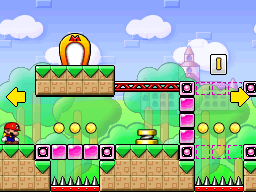
|
Floor 1 Mushroom Mayhem A floor that introduces the player to controlling Mini Marios and manipulating Color Blocks. Each of the nine main levels on this floor features Pink Blocks. Other level elements on this floor include Yellow Springs, Blue Springs, conveyor belts, elevators, and Spikes. Shy Guys, Piranha Plants, and Circus Kongs appear on this floor as enemies. Rooms 1-1 • 1-2 • 1-3 • 1-4 • 1-5 • 1-6 • 1-7 • 1-8 • 1-9 • Boss Game 1 |
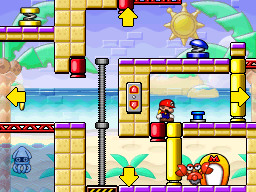
|
Floor 2 Tropical Island A floor that introduces and highlights Color Switches, sliding doors, and sliding bridges. This floor also introduces rafts, water, Bloopers, Cuttacuttas, and a single Capture Kong. Rooms 2-1 • 2-2 • 2-3 • 2-4 • 2-5 • 2-6 • 2-7 • 2-8 • 2-9 • Boss Game 2 |
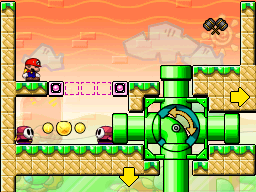
|
Floor 3 Pipe Works A floor that highlights Warp Pipes and introduces Rotate Pipes and Water Valves, as well as Crash Kongs. Rooms 3-1 • 3-2 • 3-3 • 3-4 • 3-5 • 3-6 • 3-7 • 3-8 • 3-9 • Boss Game 3 |
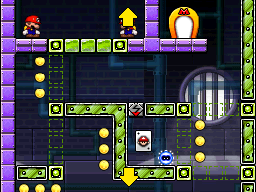
|
Floor 4 Magnet Mania A floor that introduces and highlights magnet-based objects, including Magnet Ground, Magnetic Blocks, Rotating Magnet Sticks, and Magnet Sparkies. This floor also introduces Swing Bars, Donut Blocks, and Cool Kongs. Rooms 4-1 • 4-2 • 4-3 • 4-4 • 4-5 • 4-6 • 4-7 • 4-8 • 4-9 • Boss Game 4 |
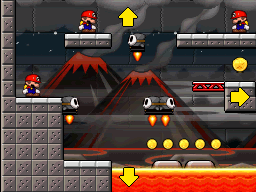
|
Floor 5 Lava Dome A floor that introduces and highlights fire-based objects, including lava, Spyguys, Fire Bars, Lava Fountains, Podoboos, and Fire Blocks, which allow the player to destroy logs when picked up. Rooms 5-1 • 5-2 • 5-3 • 5-4 • 5-5 • 5-6 • 5-7 • 5-8 • 5-9 • Boss Game 5 |
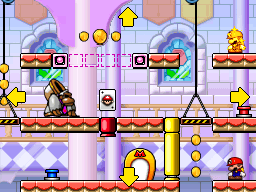
|
Floor 6 Toadstool Castle A floor based on Peach's Castle that introduces Moving Platforms and Balance Beams. Rooms 6-1 • 6-2 • 6-3 • 6-4 • 6-5 • 6-6 • 6-7 • 6-8 • 6-9 • Boss Game 6 |
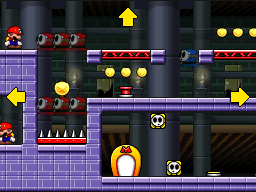
|
Floor 7 Spooky Attic A floor that introduces Polterguys, which can be manipulated by Color Switches. Other new enemies on this floor include Candles and Mummy Guys. Rooms 7-1 • 7-2 • 7-3 • 7-4 • 7-5 • 7-6 • 7-7 • 7-8 • 7-9 • Boss Game 7 |
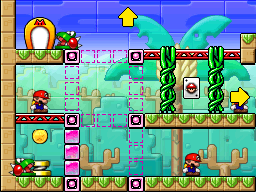
|
Floor 8 Jungle Hijinks A floor that introduces Bomb Blocks. When picked up, they allow the player to place bombs that can destroy rocks. New enemies that appear on this floor include Kongā, Snapjaws, Snifits, and a single bird during the battle against Donkey Kong. Rooms 8-1 • 8-2 • 8-3 • 8-4 • 8-5 • 8-6 • 8-7 • 8-8 • 8-9 • Boss Game 8 |

|
Roof The floor that hosts the final boss battle against Donkey Kong. Room Final Boss |
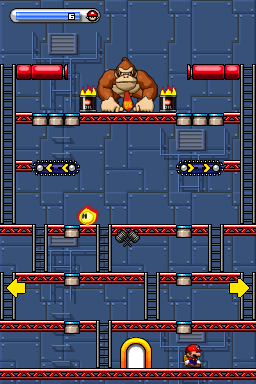
|
Basement DK's Hideout A hidden floor unlocked after completing the main adventure, containing two levels that require a certain amount of stars to unlock. Rooms B1 • B2 |
Items and objects
| Item | About |
|---|---|
| A coin adds 50 points to the score when collected by a Mini. | |
| A Large Coin adds 500 points to the score when collected by a Mini. | |
| Mini Mario Cards are collectible items, with a picture of Mini Mario on one side and a letter on the other side. There are 9 Mini Mario Cards on each of the first eight floors. | |
| The objective of each level is to guide at least one Mini to the exit. | |
| Pink Blocks are objects that can be picked up and placed inside of block outlines. | |
| Yellow Springs are used to fling Minis to higher places. | |
| Blue Springs are used to fling Minis to higher places and forwards at the same time. | |
| Spikes are hazards which destroy a Mini upon contact. | |
| Girders are platforms that Minis can reach from below using a Yellow Spring or Blue Spring. | |
| Conveyor belts send Minis moving in a certain direction. | |
| In levels that feature conveyor switches, the directions of all conveyor belts in the level can be reversed by tapping a conveyor switch with the stylus. | |
| Hammers are found floating in some levels. When collected, hammers allow a Mini to defeat or temporarily stun enemies. | |
| Elevators are platforms that move up and down by tapping their control panel with the stylus. Once the direction of the elevator is selected, it cannot be changed until the elevator reaches a ledge. An elevator can hold up to two Minis. | |
| When pressed, a Color Switch can manipulate sliding bridges, sliding doors, and Polterguys. There are three colors of Color Switches: red, yellow, and blue. | |
 Sliding door Sliding door
|
When a Color Switch is pressed, sliding doors of the same color extend, while sliding doors of different colors retract. |
 Sliding bridge Sliding bridge
|
When a Color Switch is pressed, sliding bridges of the same color extend, while sliding doors of different colors retract. |
| An object that Minis can board to traverse deep bodies of water. | |
| A ? Block reveals a Fire Flower when struck from below by a Mini. | |
| An item that comes out of a ? Block. When collected, it temporarily turns a Mini into its fire form, which allows it to throw fireballs for a limited time to defeat or stun enemies. | |
| Crumble Blocks crumble and disappear shortly after a Mini walks over them. | |
| Warp Pipes send Minis that enter them to a different part of the level. | |
 Rotate Pipe Rotate Pipe
|
Rotate Pipes are sections of Warp Pipes that can be rotated with the stylus to connect different ends of Warp Pipes together. |
 Water Valve Water Valve
|
Water Valves dispense water when swiped with the stylus, causing the water level of certain areas to either rise or fall. They only appear in Room 3-2 and Room 6-2. |
| Magnet Ground allows Minis to walk in any direction, including on walls and upside down. | |
| Magnetic Blocks allow Minis to walk in any direction, including on walls and upside down. They can be picked up and placed within a level. | |
| Swing Bars are objects that can be used to cross gaps. Swing Bars with a handle can also be used to launch Minis upward. | |
| Rotating Magnet Sticks can be swiped with the stylus to change the position of Minis or Magnet Sparkies on them. | |
| A block that falls after being walked on by a Mini. | |
 Wall Jump Bar Wall Jump Bar
|
When a Mini slides against a Wall Jump Bar, it can Wall Jump if the player taps it with the stylus. |
| Fire Blocks can be picked up and placed, similarly to Pink Blocks. However, when picked up, they allow the player to produce a Fireball by holding the stylus onto the Touch Screen. | |
| Logs can be burned and destroyed by the Fireball produced from picking up Fire Blocks. | |
| Water drops create a shield around a Mini, protecting them from hazards for a short time. | |
| A platform that moves by itself horizontally or vertically. Unlike elevators, only one Mini at a time can board a Moving Platform. | |
| An object with two platforms connected to a pulley system. If one of the platforms has more Minis on it, it lowers while the other platform rises. Both platforms move to a middle position if they have the same number of Minis. | |
| Crates are solid objects that obey gravity and can be moved by conveyor belts. | |
| Vines are solid walls that can be destroyed by Snapjaws, which eat any vines they touch. | |
| Bomb Blocks can be picked up and placed, similarly to Pink Blocks. However, when picked up, they allow the player to place a bomb. | |
| Rocks obey gravity and do not crumble upon contact with a Mini, but can instead be destroyed by an explosion from a bomb. | |
| Ladders can be climbed by Minis to reach different heights. Most ladders are fixed, but a few periodically retract. | |
| Bolts support the girders that Donkey Kong rests on in B1. They melt and disappear if a Mini touches their blue caps or jumps over them. |
Enemies
| Enemy | About | First appearance | Last appearance |
|---|---|---|---|
Bird |
A single bird appears in Boss Game 8, which can drop down towards the Mini Mario cannon, as well as drop eggs after Donkey Kong takes damage. | Boss Game 8 | |
Blooper |
Bloopers usually remain stationary. However, if a Mini approaches them, they jump and hover in the air for a short time, allowing Minis to pass under them. | Room 2-3 | Room 2-5 |
Bob-omb |
Bob-ombs only appear in Shy Guy Smash!. Tapping them causes them to explode, subtracting 5 points from the score. | Shy Guy Smash! | |
Bob-omb Fish |
Bob-omb Fish only appear in Special Kit 3 in the Construction Zone. If a Mini Donkey Kong gets close to them, they rise to the water's surface and explode. | Special Kit 3 | |
Candle |
Candles quickly rise and lower from a set position, burning any Minis that touch them. | Room 7-1 | Room 7-4 |
Capture Kong |
Capture Kongs capture any Minis they touch. They can be stunned by a Mini using hammers, freeing any Minis they have captured. | Room 2-6 | Room 8-9 |
Circus Kong |
Circus Kongs toss Minis into the air, and can be stunned by a Mini using hammers. | Room 1-6 | Room 8-4 |
Cool Kong |
Cool Kongs can transport Minis to different locations if they grab onto a Cool Kong's tie or stand on its head. | Room 4-6 | Room 7-4 |
Crash Kong |
Crash Kongs charge at Minis, attempting to flatten them into a wall. Minis can stand on them. | Room 3-6 | Room 8-6 |
Cuttacutta |
Cuttacuttas move from left to right and can extend their claw to break Minis. | Room 2-5 | Room 2-9 |
Fire Bar |
Fire Bars burn any Minis that come into contact with their fireballs. | Room 5-1 | Boss Game 5 |
Fireball |
Fireballs move along the ground and can climb ladders. They can be defeated by a Mini with hammers. | Roof | B2 |
Jack |
Unlike other springs, jacks bounce around dangerously. | B1 | B2 |
Kongā |
Kongā automatically fall extremely fast and rise slowly, and can be stood on by a Mini. | Room 8-1 | Room 8-4 |
Magnet Sparky |
Magnet Sparkies move along magnetic objects. Their path can be changed by placing Magnetic Blocks or flipping a Rotating Magnet Stick. | Room 4-5 | Room 4-7 |
Mummy Guy |
Mummy Guys break if a Mini stands on them, but come back to life shortly afterwards. | Room 7-1 | Room 7-7 |
Piranha Plant |
Piranha Plants spit fireballs, which can burn Minis they touch. | Room 1-3 | Room 7-8 |
Phantom Guy |
Phantom Guys move between fixed positions, and can be turned into harmless blocks using Color Switches. | Room 7-2 | Room 7-7 |
Podoboo |
Podoboos jump out of lava, and can burn any Minis they touch. | Room 5-3 | Room 5-7 |
Shy Guy |
Shy Guys are basic enemies that Minis can stand on and defeat using hammers. | Room 1-4 | Room 6-6 |
Spyguy |
Spyguys are Shy Guys that hover in midair. Their jet flame can burn Minis. | Room 5-1 | Room 5-7 |
Snapjaw |
Snapjaws eat any vines they touch, reaching a different height and opening a new area in the process. | Room 8-2 | Boss Game 8 |
Snifit |
Snifits wind up before shooting a stream of five bullets. They can be stood on by Minis. | Room 8-6 | Room 8-9 |
Swoop |
Swoops only appear in Boss Game 7, where they attempt to swoop down at the Mini Marios. | Boss Game 7 | |
Thwomp |
Thwomps fall down and attempt to crush approaching Minis. | Room 3-4 | Room 7-8 |
Donkey Kong |
Donkey Kong is fought as a boss at the end of each floor. | Boss Game 1 | B2 |
Reception
| Reviews | |||
|---|---|---|---|
| Release | Reviewer, Publication | Score | Verdict |
| Nintendo DS | Craig Harris, IGN | 7/10 | "The original Mario vs. Donkey Kong is a far better puzzle game than March of the Minis is, but that doesn't make this game a bad one. It is a clever Lemmings-inspired, touch screen design with a great focus on user-submitted content to keep the game going on and on. Its similarities to the first game are only in looks; the concept goes in a refreshingly different -- but just not as successful, addictive or challenging -- direction for Nintendo DS gamers." |
| Nintendo DS | Jeff Gerstmann, Gamespy | 3.5/5 | "So, in a nutshell, Mario vs. Donkey Kong 2 is a mixed blessing. It's got some fun and elaborate puzzles, although some get a tad too elaborate to manage at once. Also, certain parts of the gameplay mechanic, such as the responsiveness of the touch screen while steering Mini-Marios around, don't function as well as we would have liked. Still, for those who find themselves drawn to the game, the title's stringent requirements for a gold star will generate lots of replay value, just as the excellent Wi-Fi setup will. Even if Mario vs. Donkey Kong 2 apes Lemmings on PSP (again, no pun intended), it emulates most of that game's best elements, although its flaws seem to be rooted in both the hardware and its inability to sustain the previous game's sense of joy." |
| Nintendo DS | Kristan Reed, Eurogamer | 7/10 | "So what's this pleasant puzzle diversion worth in the grand scheme of all things DS? On the plus side there's nothing quite like March of the Minis on the platform; it's yet another game oozing with intuitive Nintendo design genius that makes it an instantly pleasurable game to pick up and enjoy from the start. But although it's the sort of game that lends itself perfectly to short commutes and coffee breaks, its strengths are also its Achilles heel - many won't appreciate the simplicity, or the fact that there doesn't appear to be enough of a substantial challenge to grab your attention for very long. Not for everyone, then, but well worth further investigation if puzzling's your thing." |
| Aggregators | |||
| Compiler | Platform / Score | ||
| Metacritic | 76 | ||
| GameRankings | 77.50% | ||
Staff
Pre-release and unused content
Gallery
- For this subject's image gallery, see Gallery:Mario vs. Donkey Kong 2: March of the Minis.
Mario and the Mini Mario toys chasing after Donkey Kong with Pauline
Media
| It has been requested that at least one audio and/or video file related to this article be uploaded. Please upload all related music, sound effects, voice clips, or any videos for this article. See the help page for information on how to get started. |
Music
Most of the music tracks featured in the game are arrangements of music from other games in the Super Mario franchise. There are only two original compositions in the entire game: one is the theme that plays in Pipe Works levels, and the other is the theme that plays in various menus, such as the floor selection screen, the Construction Zone, and the Options menu, although this theme does use the 25m theme from Donkey Kong as a leitmotif.
In levels from each of the first eight floors, a single music track is used for all of the levels on a floor, but that track starts from a different measure depending on the specific level being played.
If Mini Marios appear on the title screen, a trumpet arrangement of the title theme from Mario vs. Donkey Kong plays. If Mini Toads, Mini Peaches, or Mini Donkey Kongs appear on the title screen, the Mario vs. Donkey Kong title theme itself plays.
Arrangements
| Music | Arrangement of |
|---|---|
| Mushroom Mayhem / Special Kit 1 | #-MM level theme from Mario vs. Donkey Kong |
| Tropical Island | First theme from Donkey Kong Jungle from Mario vs. Donkey Kong |
| Magnet Mania | "Underground Theme" from Super Mario Bros. |
| Lava Dome | Bowser's Castle theme from Super Mario Bros. |
| Toadstool Castle / Special Kit 2 | "Inside the Castle Walls" from Super Mario 64 |
| Spooky Attic | First theme from Spooky House from Mario vs. Donkey Kong |
| Jungle Hijinks / Special Kit 3 | "DK Island Swing" from Donkey Kong Country |
| First eight boss battles | First boss theme from Mario vs. Donkey Kong |
| Roof / DK's Hideout |
|
| Credits |
|
| Shy Guy Smash! | Bonus game theme from Mario vs. Donkey Kong |
References to other games
- Donkey Kong: Pauline makes a return to the Super Mario franchise. The Roof and both levels in DK's Hideout use a structure of girders and ladders, similar to that of 25m and 75m. The "Opening", "How High Can You Get?", and 25m themes from this game are all arranged.
- Donkey Kong Jr.: Snapjaws, which were introduced in this game, are featured in Jungle Hijinks. In Boss Game 8, Donkey Kong moves on vines in a similar manner to Donkey Kong Jr., and Banana Bunches can be dropped on enemies to defeat them.
- Super Mario Bros.: Several music tracks from this game are arranged.
- Donkey Kong Country: Several music tracks from this game are arranged.
- Super Mario 64: Several music tracks from this game are arranged.
- Donkey Kong 64: Several of Donkey Kong's voice clips are recycled.
- Mario vs. Donkey Kong: Several music tracks from this game are arranged. Some of Mario’s voice clips from this game are recycled.
- Mario Power Tennis: Several of Donkey Kong's voice clips are recycled.
- Donkey Kong Jungle Beat: Several of Donkey Kong's voice clips are recycled.
References in later games
- Mario Kart 8 / Mario Kart 8 Deluxe: Mini Toads appear in GBA Ribbon Road, where they act as spectators.
Names in other languages
| Language | Name | Meaning | Notes |
|---|---|---|---|
| Japanese | マリオ Mario buiesu Donkī Kongu Tsū Mini Mini Dai Kōshin! |
Mario vs. Donkey Kong 2: Mini Mini Big March! | |
| Chinese (traditional) | 瑪利歐VS.大金剛2 迷你瑪利歐向前走![3] Mǎlìōu VS. Dàjīn'gāng 2 Mínǐ Mǎlìōu Xiàng Qiánzǒu! |
Mario VS. Donkey Kong 2: Mini Marios Move Forward! | |
| French | Mario vs. Donkey Kong 2: La Marche des Mini[?] | Mario vs. Donkey Kong 2: The March of the Minis | |
| German | Mario vs. Donkey Kong 2: Marsch der Mini-Marios[?] | Mario vs. Donkey Kong 2: March of the Mini-Marios | |
| Italian | Mario vs. Donkey Kong 2: La marcia dei Minimario[?] | Mario vs. Donkey Kong 2: The march of the Minimarios | |
| Spanish | Mario vs. Donkey Kong 2: La Marcha de los Minis[?] | Mario vs. Donkey Kong 2: The March of the Minis |
References
- ^ a b c d Nintendo (2006). Mario vs. Donkey Kong 2: March of the Minis North American instruction booklet. Nintendo of America (American English). Retrieved June 26, 2022.
- ^ Zephiel810 (February 21, 2017). Mario vs. Donkey Kong 2: March of the Minis - 100% Walkthrough - World 2: Tropical Turmoil. YouTube (English). Retrieved June 22, 2024.
- ^ Nintendo DS 遊戯軟體. Nintendo Taiwan (Traditional Chinese). Retrieved June 22, 2024. (Archived March 13, 2019, 01:10:08 UTC via Wayback Machine.)
